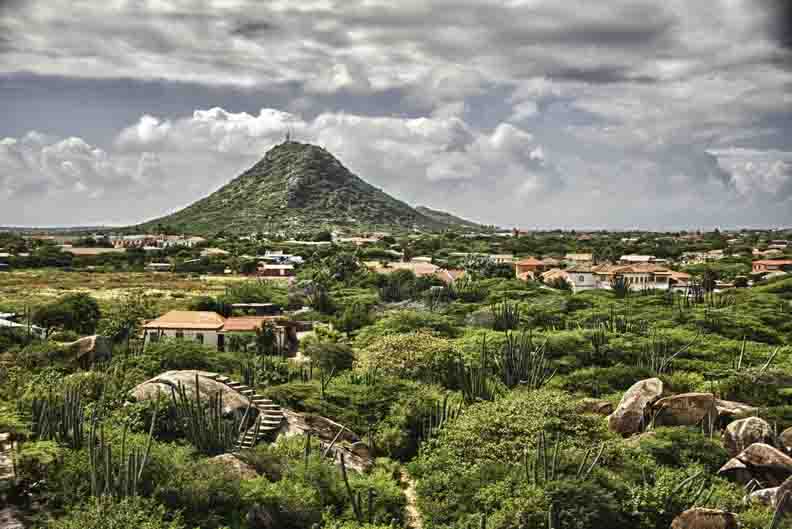Archiscape Blog

Traveling Architect: Aruba
Aruba’s interior, seen from the Casibari rock formation. All photos, Angelo Accomando
The furthest island in the Caribbean, a mere 15 miles from Venezuela, Aruba is the smallest of the ABC Islands (Aruba, Bonaire, Curacao). Its nearly constant sunshine and relatively arid weather coupled with miles of white sand and clear waters has made this a tourist mecca. But leaving the hotel strips and casinos of the West side behind, we explored the island’s ‘other’ coasts and the interior, in search of Aruba’s natural landscapes, its roots and signs of its history.
LANDSCAPE
Cactus, aloe vera and bush in the island interior, a divi-divi tree growing out of the foundations of an old gold smelter, ruins of the Bushiribana smelter, impromptu rock sculptures that cover the sand as far as one can seeBecause Aruba is outside of the hurricane belt but enjoys constant tradewinds, the weather is always pleasant. Native to Aruba are cactus trees, the Westerly-leaning divi-divi trees, aloe vera bushes and numerous colorful rock types and formations. Coral reefs close to the Western shore ensure a constant supply of fine white sand, while the East side is a rougher shore, with cliffs and rocky beaches. Luckily the Spanish who claimed the island in 1499 and the Dutch who took over in 1636 didn’t find the island particularly useful, hence both the natural landscape and the native Arawak Indians who lived there survived. Gold was discovered in 1824, but closed a century later. Ruins from 2 of the smelters can be visited.
COUNTRYSIDE ARCHITECTURE
Steps carved into stone hill with ‘cunucu’ houses beyond, a Mediterranean-influenced cunucu house, an Italian restaurant terrace and California Lighthouse at the Island’s Northern tip
Aruba’s “cunucu” or countryside is dotted with houses of Dutch origin which have been embellished and re-designed over generations. One can see the influences of the main peoples of the island – Spanish, Dutch, Portuguese and African. A French-designed lighthouse named after the sunken ‘California’ steamboat nearby offers vistas over the entire island.
CITY SIMPLICITY
Colorful forms and crisp details mark earlier Dutch design: crisp white window details against backgrounds of red, blue and yellow; Fort Zoutman (1796) with Willem III Tower (1868) in background
In Aruba’s capital city of Oranjestadt, the Dutch influence is very prominent. Colorful and playful forms have been built since the early days. A combination of Mediterranean villa types and Dutch row-house types line the streets.
CITY ORNAMENTED
Crisp white ‘filigree’ against bright or pastel backgrounds mark later Dutch design
Aruba became more prosperous in the early 1900s when a large oil refinery was built in the Southern part of the island. Soon after tourism became a large part of the economy. Buildings in the city’s most visible or more visited blocks became more grandiose and more ornamented. The resulting streetscape is a mix of building types and of different styles, a reflection of those who have lived here in generations past, and who live here now.
/
Click here to read more about the “cunucu” or countryside houses of Aruba.
/
/
“Limitations live only in our minds. But if we use our imaginations, our possibilities become limitless…”
-Jamie Paolinetti
A bientôt,
Karin






